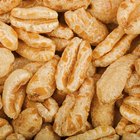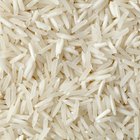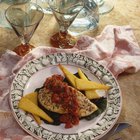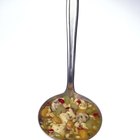
Lesyy/iStock/Getty Images
Bulgur wheat is one of the staples of the eastern Mediterranean and Middle East. It's a versatile grain product, used hot or cold in soups, salads, meat dishes and pilafs. It's quick and easy to prepare, though there are a few potential pitfalls for novices. When properly prepared it should be chewy and firm, never mushy.
About Bulgur
Like parboiled rice or steel-cut oats, bulgur is an example of an ancient grain-cooking process called groats. The grains are simmered until tender and then dried again until hard, so they can be stored indefinitely in a dry location. The starches in the grains are already cooked, so they quickly swell and soften when they're exposed again to hot water. Bulgur is milled into small, medium and large pieces, suitable for different purposes.
Grades of Bulgur
The three grades of bulgur are traditionally used in different dishes. The finest is used primarily as a filler in kibbe, a mixture of lamb and grain that can be made into meatballs or a sort of meatloaf. The medium variety is the kind used in the familiar tabouleh salad, or as a stuffing for meats or vegetables. Coarse bulgur is prepared like rice in pilafs or soups, where it makes a chewy substitute for other grains. If you're substituting one kind of bulgur for another, you might have to reduce the water or cooking time to keep it from becoming mushy.
Preparing Bulghur
The finest grade of bulgur wheat is pre-soaked, not cooked on its own. Instead, as the dish cooks, the bulgur takes as much moisture as it needs from the surrounding ingredients. Medium bulgur is usually cooked by stirring 1 cup of the grain in 2 to 2 1/2 cups of boiling water or broth, then covering it until the liquid is absorbed. The amount of liquid can be varied, depending whether a soft or firm result is intended. Coarse bulgur is simmered the same way as rice, in a tightly covered saucepan.
Troubleshooting
The most common mistake made with bulgur is cooking the medium grade in the same way as a coarse grade. Medium bulgur gently absorbs hot water as it sits, while coarse bulgur is actively simmered. Medium bulgur will usually become mushy, especially at the bottom of the pot, if it's cooked this way. Bulgur will also become mushy if too much liquid is used. If time permits, it can sometimes be salvaged by spreading the grain gently on a baking sheet and drying it in a low-temperature oven until it regains a chewy texture.
Related Articles

How to Cook Bulgar Wheat in the ...
Cooking Instructions for Cracked Wheat

How to Cook With Kamut

Directions on How to Cook Soba Noodles
Can You Eat Bulgur Like Oatmeal?
How to Cook Pressed Barley Like Rice

How to Cook Basmati Rice on the Stove
How to Cook Grits in the Microwave
How to Cook Burghal

How to Use Soaked Bulgur Wheat

How to Cook Quinoa Pasta

Polenta Substitute

Barley Nutrition Information

Does Rice Taste Different Depending on ...

How to Cook Khus Khus

Definition of Polyester Staple Fiber

Bulgar Wheat Vs. Couscous

How to Cook Couscous With Chicken Broth

How to Cook Steel Cut Oatmeal With a ...

How to Cook Pearl Barley on the Stove
References
- A New Book of Middle Eastern Food; Claudia Roden
- Recipe Tips: Cooking Bulgur Wheat
- The Cook's Thesaurus: Wheat
Writer Bio
Fred Decker is a trained chef and prolific freelance writer. In previous careers, he sold insurance and mutual funds, and was a longtime retailer. He was educated at Memorial University of Newfoundland and the Northern Alberta Institute of Technology. His articles have appeared on numerous home and garden sites including GoneOutdoors, TheNest and eHow.
Photo Credits
Lesyy/iStock/Getty Images